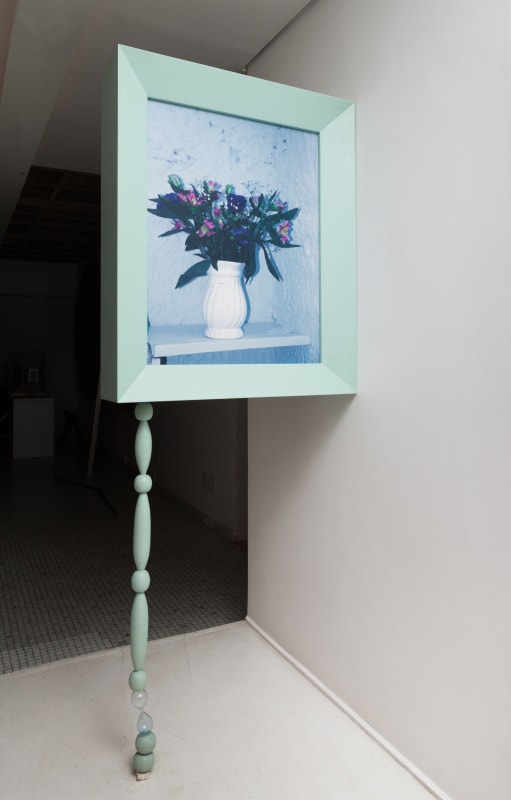Sandra Regina Cinto (Santo André, SP, 1968). Designer, painter, sculptor, engraver and teacher. Drawing is the main thread of her work, but she also transits among different artistic languages, such as installation and sculpture. In many of her works, viewers enter spaces that encourage reflection on the surrounding environment and how it is occupied.
She graduated in art education from Faculdades Integradas Teresa d'Ávila (Fatea), in Santo André, São Paulo, in 1990. The following year, she exhibited at the Laboratório de Estudos e Criação da Pinacoteca do Estado de São Paulo (Pina_). In 1992, she held her first two solo exhibitions, at Centro Cultural São Paulo (CCSP), in São Paulo, and at Galeria Espaço Alternativo, in Rio de Janeiro.
For critics Raphaela Platow and Adriano Pedrosa (1965), drawing is the essential language of Sandra Cinto, who also works with painting, sculpture, and installation. Used as a sketch in her early works, such as Retábulo (1995), in which she paints clouds on wooden surfaces, drawing becomes, in later works, the final form. As an illustrator, she did her first work in 1996, for the Folha de S.Paulo newspaper.
In 1997, she received the Acquisition Prize at the Salão de Arte Contemporânea Victor Meirelles and participated in the International Contemporary Art Fair in Madrid. From 1998 on, she teaches expression drawing at the School of Visual Arts at Fundação Armando Alvares Penteado (Faap) and coordinates, with artist Albano Afonso (1964), the study group of Ateliê Fidalga, in São Paulo.
As resident artist, she stays for six months at the Cité des Arts, in Paris, in 2000. Five years later, she receives a residency award from the Civitella Foundation, in Umbertide, Italy. Since 1990, she has had several group and solo exhibitions, such as MAM na Oca (2006), Construção (2006) and A Imitação da Água (2010).
The dimensions of landscapes change among Sandra's works. Clouds painted on small and medium-sized supports are replaced by large night skies and rough seas, made with ballpoint pen on the walls of museums and galleries, as occurs in the work Encontro das Águas (2013). The drawings are meticulous and require the use of different pens, as well as a long production time.
There is also an architectural function in the works: the drawings invite the public to immerse themselves in the landscape, referring to the sublime and to images of nature that generate feelings of vertigo and fear. The murals oppose the environment, generating oniric landscapes in the midst of urban space. The critic Angélica de Moraes (1949), for whom Sandra's work resembles creations by the painter Guignard (1896-1962), sees in her works the evocation of a "dream universe and utopia".
Along with the drawings, Sandra exhibits photographs, wooden horses, beds, and other items. These objects constitute an imaginative environment, and function as supports for the drawings, which fulfill the role of "connective tissue between the elements. The artist's line, delicate and simple, reveals the influence of Japanese drawing. In 2011, she confirms this Japanese influence in a project for Sesc Santo André, called Céu e mar para presente (Japonism). In it, she applies silkscreened tiles to the walls surrounding a swimming pool. Beyond visual issues, philosophy is present, through Zen, emptiness, and the need to value time.
Books are other constant elements in Sandra Cinto's works, but most of the time they appear closed and as part of the installations. An example of this is the work En Silencio II (2014), in which an office evokes the emptiness of the creative space faced by the worker. Stacked on a table, books become supports for a cello, surrounded by unfinished scores. In the same year, the artist creates Partitura, an installation that exhibits open books for the first time.
As in En Silencio II, the absence of the human figure is striking in the artist's production. According to her, the human factor is contemplated by the presence of the spectators and their occupation of the exhibition space, in convergence with the work.
In 2017, Sandra creates the immersive installation Biblioteca do Amor [Library of Love], at the Contemporary Arts Center (CAC), in Cincinnati, USA. The collective project brings to the public about 200 book-objects, fruits of the reflection of artists, established and beginners, who think about love in its different manifestations, also considering its absence. The project takes place in a reading room, in which the library and the art installation converge in the so-called Contemplation Room.
The space in the CAC's living area is created with the goal of broadening reflection. It is configured as a collective action to observe the human relationships proposed by the artists' books, in an environment of constant transit.
By creating counterpositions between the works and the environment that surrounds them, Sandra generates atmospheres of dream and utopia. The drawings and installations take the public to spaces of meditation and reflection on the order of time and the relationships around them.
SANDRA Cinto. In: ENCICLOPÉDIA Itaú Cultural de Arte e Cultura Brasileiras. São Paulo: Itaú Cultural, 2021. Available at: <http://enciclopedia.itaucultural.org.br/pessoa10461/sandra-cinto>. Accessed on: June 26, 2021. Encyclopedia entry. ISBN: 978-85-7979-060-7

